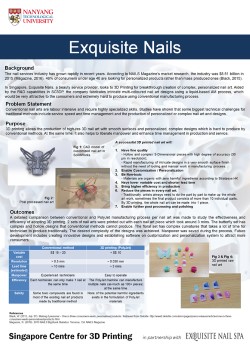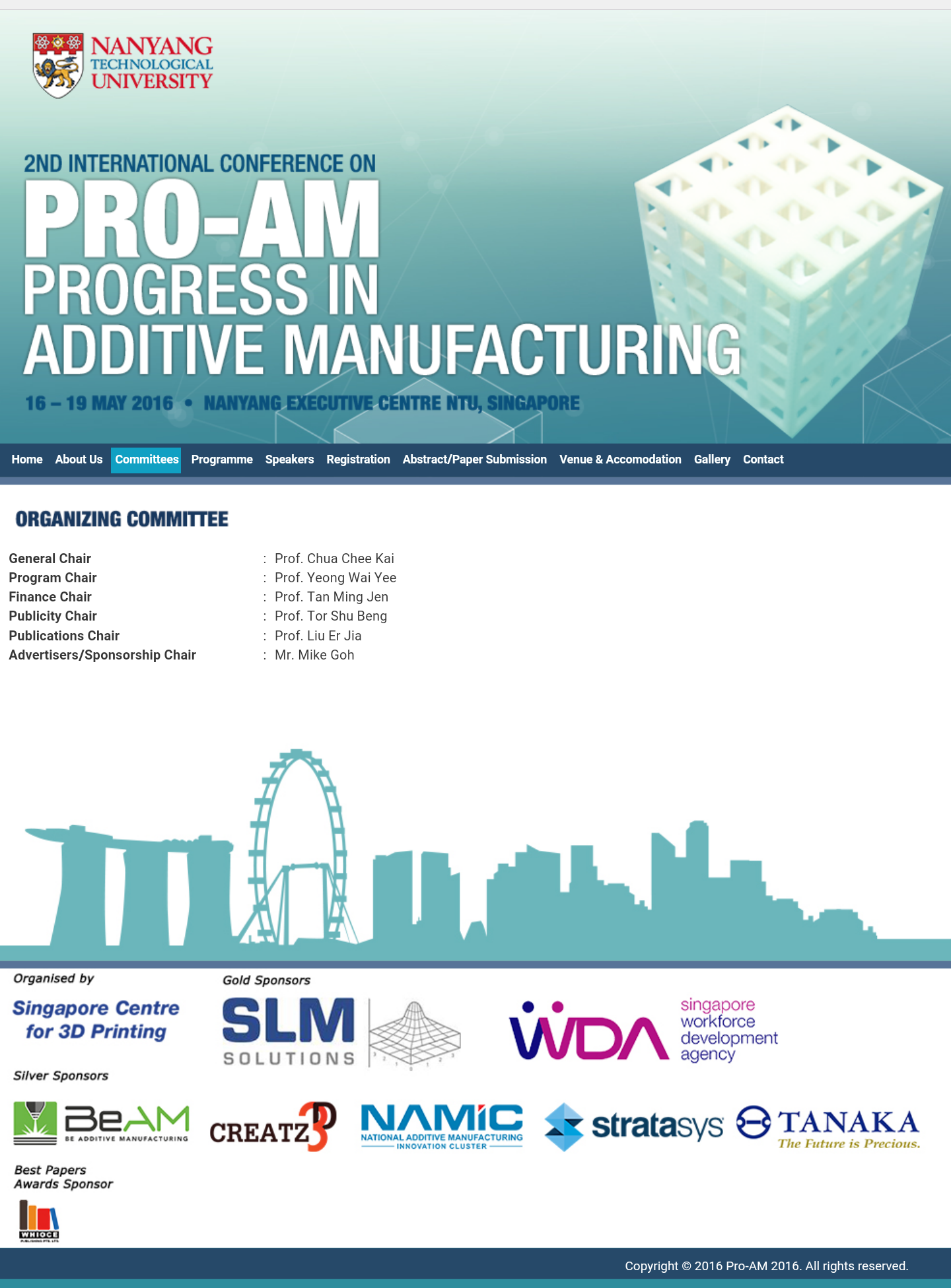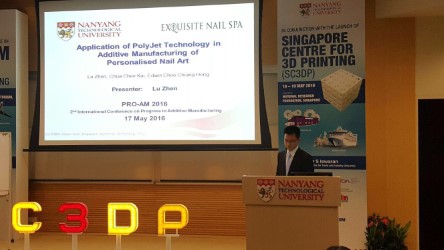Singapore Centre for 3D Printing, Nanyang Technological University, 50 Nanyang Avenue
Singapore, 639798, Singapore
EDWIN CHIANG HONG CHOO
EXQUISITE NAILS, No. 2, First Street, Siglap V, #01-03
Singapore, 458287, Singapore
ABSTRACT: Nail art market is growing worldwide and consumers are looking for more complicated and detailed nail art designs. In this present work, commercial and non-toxic nail art has been successfully manufactured in full colours by using PolyJet rigid opaque materials via PolyJet Objet 500 Connex 3 machine. Liquid-based additive manufacturing was found to be preferable to build hollow or complex-shaped parts with thin walls. In this paper, 2 sets of nail art were designed, manufactured out and evaluated. The results showed that PolyJet can help to enhance the productivity and efficiency of the nail art making process compared with traditional method. The results also suggested that PolyJet technology may bring potential profits and cost savings to the company and nail art industry by technological innovation.
KEYWORDS: Additive Manufacturing, Nail Art, 3D Printing Fashion, PolyJet Connex 3, Personalised Products
INTRODUCTION
Integrating additive manufacturing technologies into the manufacturing industries has raised many countries’ attention such as China, the United States and Singapore. Various investment was made to develop and promote additive manufacturing across the industry (Sun, 2013). PolyJet is one such additive manufacturing technology, which builds an object in successive layers by jetting drops of UV curable liquid polymers on the build tray, like inkjet printing (Chua et al., 2014). PolyJet is capable of producing final products in fine details and with smooth surface. In addition to its high resolution, PolyJet can also produce prototypes faster compared to other liquid-based additive manufacturing technologies (B. Vaupoti?*, 2006).
Worldwide, the market of nail art is growing as more ladies would prefer to paint their nails or wear nail art. The nail art industry size was $7.47 billion in 2012 and was believed to grow larger in the coming future (MAGAZINE, 2012). This brings a huge potential market for the nail art industry. Currently, most nail art companies need to heavily rely on experienced technicians in producing fine nail art for customers, which limits the scale of production (wikiHow, 2016). Some of the nail designs, as demanded by the consumers, would have hollow or complex 3-dimensional structures or features. Due to the limitation in the traditional manufacturing technology and the limitation in nail art technician’s capability, the manufacturing of some of these complex 3-dimensional structures or features are often recognised as challenging and cost-inefficient because a lot of manpower and time are needed. In addition, potential harmful ingredients such as dibutyl phthalate, toluene, and formaldehyde, commonly exist in the existing nail art (Wiles, 2000) (World, 2013). Therefore, innovative and cost-saving approach in manufacturing non-toxic nail art, such as additive manufacturing, is demanded by the companies and the nail art industry.
 Currently, some companies have already attempted to use additive manufacturing to manufacture personalised nail art for selling or publicity, such as TheLaserGirls (TheLaserGirls, 2016) and the +Ring film production team (Tampi, 2015). However, these manufactured nail art has quite rough surface because they used power-based additive manufacturing approaches, mainly ColourJet 3D Printing via 3D Systems’ ProJet 660 (Tampi, 2015) and Selective Laser Sintering (SLS) via EOS’s machines (Shapeways, 2016). A lot of work is needed to polish the surface and the products may not meet consumers’ expectation while SLS also manufacture products in multiple colours. Hence, liquid-based additive manufacturing – PolyJet technology was proposed to help to enhance the productivity and efficiency of the nail art making process compared with traditional method. This additive manufacturing method allows rapid manufacturing of intricate and complex design in very smooth surface finish without the need of tooling and manual work through the addition of materials in a layer by layer manner (Stratasys, How PolyJet 3D Printing Works, 2016). In this paper, PolyJet Objet 500 Connex 3 machine was used to manufacture 2 sets of personalised nails according to consumers’ demand, where the personalised nails were evaluated in terms of aesthetic feeling and surface finish. This paper also discussed whether the implementation of PolyJet technology would bring potential profits for the company and nail art industries. Furthermore, attempts were made to investigate the safety of the manufactured nails as well as the efficiency and productivity of the manufacturing process.
Currently, some companies have already attempted to use additive manufacturing to manufacture personalised nail art for selling or publicity, such as TheLaserGirls (TheLaserGirls, 2016) and the +Ring film production team (Tampi, 2015). However, these manufactured nail art has quite rough surface because they used power-based additive manufacturing approaches, mainly ColourJet 3D Printing via 3D Systems’ ProJet 660 (Tampi, 2015) and Selective Laser Sintering (SLS) via EOS’s machines (Shapeways, 2016). A lot of work is needed to polish the surface and the products may not meet consumers’ expectation while SLS also manufacture products in multiple colours. Hence, liquid-based additive manufacturing – PolyJet technology was proposed to help to enhance the productivity and efficiency of the nail art making process compared with traditional method. This additive manufacturing method allows rapid manufacturing of intricate and complex design in very smooth surface finish without the need of tooling and manual work through the addition of materials in a layer by layer manner (Stratasys, How PolyJet 3D Printing Works, 2016). In this paper, PolyJet Objet 500 Connex 3 machine was used to manufacture 2 sets of personalised nails according to consumers’ demand, where the personalised nails were evaluated in terms of aesthetic feeling and surface finish. This paper also discussed whether the implementation of PolyJet technology would bring potential profits for the company and nail art industries. Furthermore, attempts were made to investigate the safety of the manufactured nails as well as the efficiency and productivity of the manufacturing process.
METHODOLOGY
Nail art designs
 Nail art industrial partner had provided current existing nail art samples for reference. According to market survey and past years’ selling record, most customers purchasing nails, would prefer butterfly and floral designs. Therefore, as advised by industry partner, 2 sets of nails were designed for this paper, 1 set of butterfly designs and 1 set of floral designs. Designs were also modified based on customer’s feedback and demand. SolidWorks software was used to create the 3D Computer-Aided Design (CAD) models in SLDPRT format for customer’ nails. 1 selected butterfly design and 1 selected floral design are shown as in Figure 1. (a) and (b) below.
Nail art industrial partner had provided current existing nail art samples for reference. According to market survey and past years’ selling record, most customers purchasing nails, would prefer butterfly and floral designs. Therefore, as advised by industry partner, 2 sets of nails were designed for this paper, 1 set of butterfly designs and 1 set of floral designs. Designs were also modified based on customer’s feedback and demand. SolidWorks software was used to create the 3D Computer-Aided Design (CAD) models in SLDPRT format for customer’ nails. 1 selected butterfly design and 1 selected floral design are shown as in Figure 1. (a) and (b) below.
Figure 1. (a) 3D butterfly-design CAD nail model. (b) 3D floral-design CAD nail model
The SLDPRT format file was later saved as STL file and Magics software was used to fix and repair these STL files. These STL files were opened and arranged in Objet Studio software to prepare the manufacturing plate while the colours and manufacturing settings of each individual part was chosen in the Objet Studio software. Afterwards, PolyJet Objet 500 Connex 3 machine was used to manufacture these personalised nails in successive layers, where the personalised nails were evaluated in terms of aesthetic feeling and surface finish. Furthermore, the safety of the manufactured nails was also investigated. At the same time, the same CAD model was made by different PolyJet technology’s materials to produce the nails in different colours to identify the colours that have the highest similarity with the existing nails on the market. The machine we used was Objet 500 Connex 3 by Stratasys Ltd. and the materials we used were PolyJet rigid opaque materials, including VeroCyanPLUS, VeroWhitePLUS, VeroMagentaPLUS and FullCure 705 (Stratasys, 3D Printing With Rigid Opaque Material, 2016).
PolyJet printing
All personalised nails were manufactured by a mixture of VeroCyanPLUS, VeroWhitePLUS and VeroMagentaPLUS materials under Glossy mode. FullCure 705 material was used as supporting structures. There are 2 available printing modes for PolyJet Objet 500 Connex 3 machine – Glossy mode and Matte mode (Stratasys, Specifications of Connex 3 Systems, 2016). Glossy mode is used instead of Matte mode for this paper because products manufactured under Glossy mode would give a smooth and shiny surface, which made the manufactured nails more attractive to customers.
Digital Material printing mode was used. There are 3 available printing modes for PolyJet Objet 500 Connex 3 machine – Digital Material printing mode, High Speed printing mode and High Quality printing mode (Stratasys, Specifications of Connex 3 Systems, 2016). High Quality printing mode is used when single material is printed in the highest resolution at 16 µm while High Speed printing mode is used when single material is manufactured in a faster approach where the resolution is at 30 µm. For full colour manufacturing, Digital Material printing mode, which gives a resolution at 30 µm, has to be used. After manufacturing was done, post processing, mainly using water gun, was carried out to remove all the wax-like supporting structures around the final products.
RESULTS AND DISCUSSION
Figure 2 presents the final manufactured non-toxic butterfly-design nail art by PolyJet Objet 500 Connex 3 machine in full colours. Each one is around 25 mm in length and around 8 mm in width. Size varies due to different nails.
Figure 2. Back view of the glossy butterfly-design nails
10 nails took around 30 minutes to be manufactured in 1 job by PolyJet Objet 500 Connex 3 machine. The main features of the personaliz nails were clearly recognised and the colours were also featured as planned. The Glossy setting gave a smooth and shiny surface. Post-processing of these nails were easily done (use of water gun at a low pressure could remove the supports for manufactured nails easily), which took around 20 -30 seconds to post-process one piece of nail.
Figure 3 and Figure 4 below show other manufactured nail art in different views.
Figure 3. Top view of the glossy nails
Figure 4. Top view of the glossy nails
As shown from the pictures, details and complex designs such as the hollow structures on butterfly-design’s wings were manufactured out clearly. At the same time, very little effort was needed in the post processing stage because the support can be easily removed by water gun. Hence, manpower could be saved by using PolyJet machine. In terms of aesthetic feeling, the final quality of the nails largely depends on the designers’ designing and modelling skills. Once an appropriate design, which has a minimum thickness of 1 mm, is created by the designer, the PolyJet machine would be able to produce the final product with fine quality.
Furthermore, the manufactured nails are non-toxic as PolyJet materials are organic and none of the following potential harmful ingredients (formaldehyde, dibutyl phthalate, toluene, allergens camphor and formaldehyde resin) exist in the formulation of PolyJet materials (Stratasys, 3D Printing With Rigid Opaque Material, 2016).
Therefore, PolyJet technology provides a more efficient and more productive approach to manufacture personalised nails and may help to generate potential profits for the company due to technological innovation. Table 1 is a summary table that shows the comparison between traditional nail-making method and PolyJet approach to make 1 piece of personalised nail.
Table 1. Comparison between traditional method and PolyJet Technology of manufacture the nail art per piece
Traditional Method PolyJet Technology
Resolution > 0.5 mm ~ 0.030 mm
Lead time ~ 10 mins ~ 3 mins
Manpower Need experienced technicians to work on throughout the whole nail-making process; PolyJet is easy to operate. Once starting working, it can be left alone and there is no need to look after it.
Efficiency Each technician can only make 1 nail at the same time The PolyJet machine can manufacture multiple nails (as much as 100+ pieces) at the same time
Safety Some toxic compounds are found in most of the existing nail art products made by traditional method None of the potential harmful ingredients exists in the formulation of PolyJet materials
CONCLUSION
The approach of using PolyJet technology to manufacture nail art was used and studied. The personalised non-toxic nail models were manufactured in fine quality (~30 µm in resolution) and in full colours by PolyJet Objet 500 Connex 3 machine. Glossy mode would be preferred when manufacturing nail models because a smooth and shiny surface could be achieved. Manpower was saved during the process because it took little effort to operate and monitor the whole manufacturing process. Therefore, efficiency and productivity of making personalised nails are enhanced by using PolyJet technology. None of the potential harmful ingredients existed in the formulation of PolyJet materials as well. However, the final quality of the nails largely depends on the designers’ designing and modelling skills. It needs to be mentioned that PolyJet could only manufacture appropriate complex designs. Hence, experienced designers are needed. The company and the nail art industry also need to take note of the high start-up cost due to the high cost of the PolyJet Objet 500 Connex 3 machine. Nevertheless, it is believed that PolyJet technology has provided a more productive and efficient approach for nail art industry to manufacture personalised nail art based on customers’ demands. Future work could be carried out to further study and analyse the cost and benefit at the implementation stage in large scale and longer business cycles. The possibility of bringing 4D printing concept could also be explored and investigated, where the manufactured nails can change shape automatically upon stimulus of the environment.
ACKNOWLEDGMENTS
This project is funded under SPRING The Innovation & Capability Voucher (ICV) funding (ICV201529915). The authors are grateful to Singapore Centre for 3D Printing, Nanyang Technological University, Singapore, Exquisite Nails and TechBridge Ventures for their support as well as Ms Shi Ganyu and Ms Shen Fuyang for their assistance in the 3D modelling process and feedback on the manufactured nail art.
REFERENCES
- Vaupoti?*, M. Brezo?nik, J. Bali? (2006). Use of PolyJet technology in manufacture. Journal of Achievements in Materials, 18(1-2), 319-322.
Chua, C. K. & Leong, K. F. (2014). 3D Printing & Additive Manufacturing Principles and Applications Fourth Edition. World Scientific.
NAILS MAGAZINE (2012). Record-Breaking Gorwth: $7.47 billion in nail services. NAILS MAGAZINE.
Shapeways. (2016). How does Shapeways 3D Printing Work? (Shapeways, Inc.) Retrieved February 25, 2016, from https://www.shapeways.com/getting-started/rapid-prototyping?li=footer
Stratasys. (2016). 3D Printing With Rigid Opaque Material. (stratasys Ltd.) Retrieved February 25, 2016, from http://www.stratasys.com/materials/polyjet/rigid-opaque
Stratasys. (2016). How PolyJet 3D Printing Works. (stratasys Ltd.) Retrieved February 25, 2016, from http://www.stratasys.com/3d-printers/technologies/polyjet-technology
Stratasys. (2016). Specifications of Connex 3 Systems. (stratasys Ltd.) Retrieved February 25, 2016, from http://www.stratasys.com/3d-printers/production-series/connex3-systems#specifications
Sun, C.-N. &. Wei, J. (2013). 3D Additive Manufacturing. In SIMTech Annual Manufacturing Forum 2013.
Tampi, T. (2015, April 3). 3D Printing Transforms Nail Art, Frame by Frame. (3D Printing Industry) Retrieved February 25, 2016, from http://3dprintingindustry.com/2015/04/03/3d-printing-transforms-nail-art-frame-by-frame/
TheLaserGirls. (2016). Nail Jewelry by TheLaserGirls. (TheLaserGirls) Retrieved February 25, 2016, from https://www.shapeways.com/shops/thelasergirls
wikiHow. (2016). Hot to Do Nail Art. (wikiHow) Retrieved February 25, 2016, from http://www.wikihow.com/Do-Nail-Art
Wiles, R. & Jane, H. (2000). Does A Common Chemical (Dibutyl Phthalates) In Nail Polish AND Personal Care Products Pose Risks To Human Health? ENVIRONMENTAL WORKING GROUP.
World, H. C. (2013, June 11). IS YOUR NAIL POLISH TOXIC? (Healthy Child Healthy World) Retrieved February 25, 2016, from http://www.healthychild.org/is-your-nail-polish-toxic/


Thank you for the sharing your knowledge and information its very helpful and understandable